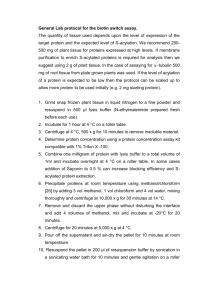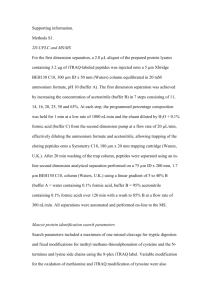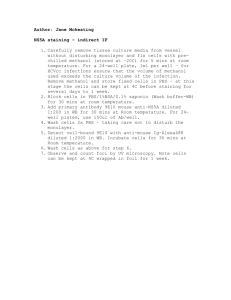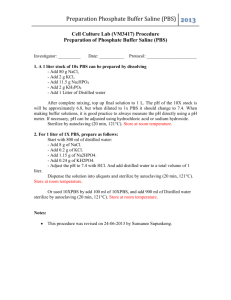Supplementary Information (docx 148K)
advertisement
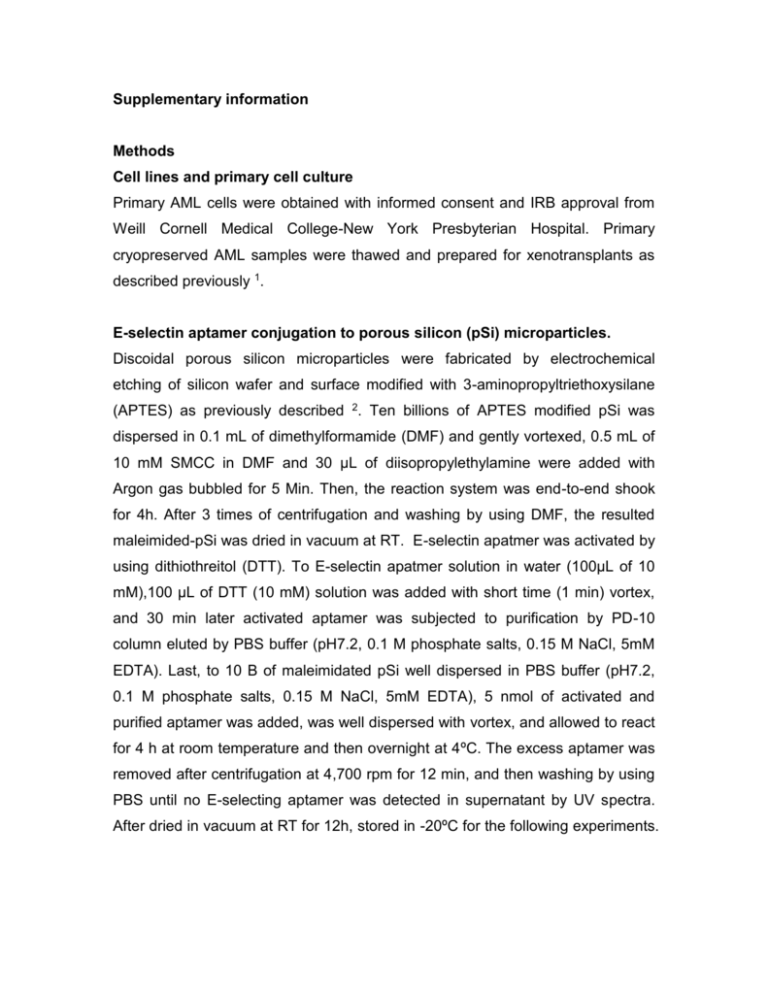
Supplementary information Methods Cell lines and primary cell culture Primary AML cells were obtained with informed consent and IRB approval from Weill Cornell Medical College-New York Presbyterian Hospital. Primary cryopreserved AML samples were thawed and prepared for xenotransplants as described previously 1. E-selectin aptamer conjugation to porous silicon (pSi) microparticles. Discoidal porous silicon microparticles were fabricated by electrochemical etching of silicon wafer and surface modified with 3-aminopropyltriethoxysilane (APTES) as previously described 2. Ten billions of APTES modified pSi was dispersed in 0.1 mL of dimethylformamide (DMF) and gently vortexed, 0.5 mL of 10 mM SMCC in DMF and 30 µL of diisopropylethylamine were added with Argon gas bubbled for 5 Min. Then, the reaction system was end-to-end shook for 4h. After 3 times of centrifugation and washing by using DMF, the resulted maleimided-pSi was dried in vacuum at RT. E-selectin apatmer was activated by using dithiothreitol (DTT). To E-selectin apatmer solution in water (100µL of 10 mM),100 µL of DTT (10 mM) solution was added with short time (1 min) vortex, and 30 min later activated aptamer was subjected to purification by PD-10 column eluted by PBS buffer (pH7.2, 0.1 M phosphate salts, 0.15 M NaCl, 5mM EDTA). Last, to 10 B of maleimidated pSi well dispersed in PBS buffer (pH7.2, 0.1 M phosphate salts, 0.15 M NaCl, 5mM EDTA), 5 nmol of activated and purified aptamer was added, was well dispersed with vortex, and allowed to react for 4 h at room temperature and then overnight at 4ºC. The excess aptamer was removed after centrifugation at 4,700 rpm for 12 min, and then washing by using PBS until no E-selecting aptamer was detected in supernatant by UV spectra. After dried in vacuum at RT for 12h, stored in -20ºC for the following experiments. Fabrication and characterization of parthenolide-containing polymeric micelles and assembly into ESTA-MSV Discoidal porous silicon microparticles were fabricated by electrochemical etching of silicon wafer as previously described3. ESTA-MSVs were modified and conjugated as described above. Co-solvent evaporation method was used to prepare parthenolide-loaded mPEG-PLA micelles. Briefly, aliquots of mPEG-PLA with parthenolide were dissolved into acetone. This solution was added dropwise into distilled water and stirred for 2 h. The remaining acetone was removed in vacuum. The micelle solution was filtered through a 0.45 µm syringe filter to remove free drug. To load parthenolide-micelles into ESTA-MSV, micelles in suspension were mixed with dry ESTA-MSVs and sonicated for 3 minutes. The micelle size and zeta potential were determined by using Malvern Zetasizer Nano-ZS (Malvern Instruments Ltd., Worcestershire, UK). Parthenolide content in micelles was detected by HPLC on LaChrom Elite HPLC System (Hitachi, Japan) equipped with C18 column (150 × 4.6 mm, 3.5 μm, Agilent) and using mobile phase consists of mixture of acetonitrile: water (55:45, v/v) at a flow rate of 1.5 mL/min and ultraviolet detection at 210 nm. NOD/SCID xenotransplantation assays Non-obese diabetic/severe combined immunodeficient (NOD/SCID) mice were obtained from the Jackson Laboratory, and sublethally irradiated with 2.7 Gy (270 Rads) before transplantation. Equal numbers of primary AML cells (2.5 × 106 cells per mouse) were then injected via the tail vein in a final volume of 0.2 mL of phosphate-buffered saline (PBS) containing 0.5% fetal bovine serum (FBS). Treatment with MSV or MSV-PTL (one billion particles) was started five weeks after transplantation via tail vein injection, once every two weeks, for four weeks. Animals were then sacrificed and the mouse bone marrow cells were harvested and analyzed for the presence of human cells by flow cytometry. For the secondary injections, equal numbers of live human CD45+ cells were injected into sublethally irradiated NOD/SCID using a total volume of 200 l/mouse. Detection and determination of PTL in plasma and bone samples from MSV-PTL-treated AML-PDX mice Plasma and femur bones from MSV-PTL treated AML-PDX mice obtained 1 h after administration of MSV-particles were removed from the animal and stored at -80 oC. Prior to analysis, bones were weighed, and pulverized using a pestle and mortar4. After addition of 1 ml of a mixture of hexane:acetonitrile (1:1), bone tissues were homogenized using a tissue homogenizer (Biospec Products, Inc., Bartlesville, OK), vortex-mixed, sonicated for 1 min and centrifuged at 10,000 rpm for 10 min at room temperature. The cycle of homogenization, vortex-mixing, sonication and centrifugation was repeated 3 successive times. The pooled supernatant was evaporated to dryness under nitrogen gas, the residue reconstituted in 30 µL of acetonitrile/methanol (1:1), and 5 µL of this solution injected onto an LC/MS/MS spectrometer (Agilent LC/MS/MS Triple Quad 6410 instrument) (Santa Clara, CA, USA). To detect PTL in plasma samples, 50 µL of control or MSV-PTL-treated plasma samples were extracted with 600 µL of acetonitrile/methanol (1:1). The mixture was vortexed for 30s, sonicated for 1 min and centrifuged at 10,000 x rpm for 10 min at room temperature. The supernatant was then evaporated to dryness at 37 °C under nitrogen gas, the residue reconstituted with 50 µL of acetonitrile/methanol (1:1) and transferred to auto-sampler vials, and 5 µL was injected onto the LC/MS/MS spectrometer. LC/MS/MS Analysis A sensitive LC/MS/MS method was successfully applied to determine the concentration of PTL in plasma and bone samples from MSV-PTL-treated mice. Analysis of PTL was carried out using an Agilent LC/MS/MS Triple Quad 6410 instrument operated in the positive electrospray ionization (ESI) mode with optimal ion source settings determined by a standard of PTL. A curtain gas of 20 psi, an ion spray voltage of 4000 V, an ion source gas1/gas2 of 35 psi and temperature of 300 °C were also employed in the collection of chromatographic data. Chromatographic separations were performed on an EC-C18 column, 2.7 µm, 4.6 X 50 mm (Agilent technologies, Santa Clara, CA) eluted with a mobile phase composed of 0.005 % formic acid and acetonitrile/methanol (1:1) containing 0.005% formic acid. PTL was eluted at 8.5 min with good resolution (Fig. 1g). Separation was achieved using a gradient of 10 to 90 % solvent B in 6.8 min, which was then equilibrated back to the initial conditions over 3.2 min. The flow rate was 0.5 mL/min with a column temperature of 30 οC. PTL MRM transitions monitored were as follows: PTL, m/z 249.1/231.1; m/z 249.1/185.1; 249.1/91.0. Flow cytometric assays The percentage of human AML cells was determined by staining the cells obtained from the BM from NOD/SCID xenotransplanted with antibodies for PECy5 conjugated rat anti-mouse CD45 (mCD45; eBiosciences) and APC-H7 conjugated anti-human CD45 (hCD45; BD Biosciences) in FACS buffer (PBS + 0.5% FBS) for 20 minutes at room temperature, washed once with FACS buffer, cells were stained with mCD45 and hCD45 antibodies as mentioned above, washed once with FACS buffer, and resuspended in Annexin V-FITC (BD Biosciences) and 7-aminoactinomycin (7-AAD; Molecular Probes-Invitrogen). Percent viability was determined by gating annexin V negative and 7-AAD negative populations. For intracellular assays, cells were stained as described above for surface markers, then cells were fixed with 4% formaldehyde (EMgrade; Electron Microscopy Sciences) at room temperature for 10 minutes, pelleted by centrifugation, and permeabilized by resuspending in cold 100% methanol on ice for 20 minutes. Cells were then washed with FACS buffer twice (0.5% FBS in PBS), and stained for 1 hour with antibodies against phospho-NF-H2AX (Cell signaling). At least 1 × 105 events were recorded per sample using a LSR II flow cytometer (BD Biosciences). Data analysis was conducted using FlowJo 9.3 software for Mac OS X (TreeStar). Confocal microscopy Cells were fixed in methanol at −20°C, and then permeabilized using blocking buffer (10% FBS and 0.1% Tween 20 in 1× phosphate-buffered saline [PBS; pH 7.4]) as described previously5. Cells were stained using rabbit anti-γH2AX (Cell Signaling Technologies) in blocking buffer for 2 hours at room temperature. Cells were washed and stained with goat anti-rabbit Alexa 488 (Invitrogen) secondary antibody. Slides were mounted using Fluoromount with DAPI (Southern Biotech). Fluorescence was observed using a 100× objective on a Zeiss confocal microscope. Immunoblotting. Cells were lysed in protein lysis buffer (50 mM Tris-HCl, pH 7.5, 150 mM NaCl, 1% Triton X- -glycerophosphate, 1 mM Na3VO4, 1 mM NaF, 1 × protease inhibitor cocktail (Calbiochem)) on ice for 30 minutes. Protein lysates were run in 10% SDS-PAGE (Invitrogen) and transferred to an Immobilon-FL polyvinylidene difluoride (PVDF) membrane (Millipore). The membrane was incubated with antibodies for phosphorylated p65, phosphohistone H2A.X Ser139 (H2AX) (Cell Signaling), and -actin (Sigma-Aldrich) at 4°C overnight, washed and incubated with IRDye 680 goat anti-rabbit or IRDye 800CW goat anti-mouse secondary antibodies (Li-COR) at room temperature for 30 minutes. The membrane was then scanned using the Odyssey imaging system (Li-COR). Statistical analysis Analyses and graphs were performed using GraphPad Prism software to evaluate significance. The specific test utilized is indicated in the figure legends *p<0.05, **p<0.01. References for supplemental information 1. Guzman ML, Yang N, Sharma KK, Balys M, Corbett CA, Jordan CT, et al. Selective activity of the histone deacetylase inhibitor AR-42 against leukemia stem cells: a novel potential strategy in acute myelogenous leukemia. Molecular cancer therapeutics 2014 Aug; 13(8): 1979-1990. 2. Godin B, Chiappini C, Srinivasan S, Alexander JF, Yokoi K, Ferrari M, et al. Discoidal Porous Silicon Particles: Fabrication and Biodistribution in Breast Cancer Bearing Mice. Adv Funct Mater 2012 Oct 23; 22(20): 42254235. 3. Ananta JS, Godin B, Sethi R, Moriggi L, Liu X, Serda RE, et al. Geometrical confinement of gadolinium-based contrast agents in nanoporous particles enhances T1 contrast. Nat Nanotechnol 2010 Nov; 5(11): 815-821. 4. Safarpour H, Connolly P, Tong X, Bielawski M, Wilcox E. Overcoming extractability hurdles of a 14C labeled taxane analogue milataxel and its metabolite from xenograft mouse tumor and brain tissues. Journal of pharmaceutical and biomedical analysis 2009 Apr 5; 49(3): 774-779. 5. Topisirovic I, Guzman ML, McConnell MJ, Licht JD, Culjkovic B, Neering SJ, et al. Aberrant eukaryotic translation initiation factor 4E-dependent mRNA transport impedes hematopoietic differentiation and contributes to leukemogenesis. Mol Cell Biol 2003 Dec; 23(24): 8992-9002.

